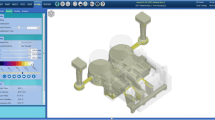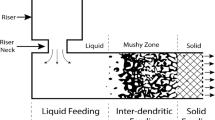Abstract
Rapid casting is the product of digital, information, and optimization of casting technology. It mainly includes rapid prototyping and virtual manufacturing. In order to shorten the production cycle of a stainless steel closed impeller casting, the wax pattern was made by high impact polystyrene (HIPS) with a selective laser sintering and photosensitive resin with stereolithography (SL). In order to prevent the formation of shrinkage defects, different gating systems designed to examine the molten metal flow and solidification behavior during the pouring and solidification process. The results show that pouring temperature is 1550 °C and pouring speed is 0.75 m/s, which is favorable for filling impeller castings, and can avoid casting defects. The optimized gating system prevented surface shrinkage and interior defects. The optimized gating systems have been verified by experiment, and the rapid casting has been realized based on 3D printing wax pattern and simulation optimization. This rapid casting can reduce processing time and costs, and enhance casting quality in the foundry industry.
Similar content being viewed by others
References
Chhabra M, Singh R (2011) Rapid casting solutions: a review. Rapid Prototyp J 17(5):328–350
Collins PK, Leen R, Gibson I (2016) Industry case study: rapid prototype of mountain bike frame section. Virtual Phys Prototyp 11(4):295–303
Wong KK, Ho JY, Leong KC, Wong TN (2016) Fabrication of heat sinks by selective laser melting for convective heat transfer applications. Virtual Phys Prototyp 11(3):159–165
Liu HJ, Fan ZT, Huang NY, Dong XP (2003) A note on rapid manufacturing process of metallic parts based on SLS plastic prototype. J Mater Process Technol 142:710–713
Yao WL, Leu MC (1999) Analysis of shell cracking in investment casting with laser stereolithography patterns. Rapid Prototyp J 5(1):12–20
Bassoli E, Gatto A, Iuliano L, Violante MG (2007) 3D printing technique applied to rapid casting. Rapid Prototyp J 13(3):148–155
Cheah CM, Chua CK, Lee CW, Feng C, Totong K (2005) Rapid prototyping and tooling techniques: a review of applications for rapid investment casting. Int J Adv Manuf Technol 25(3):308–320
Dotchev K, Soe S (2006) Rapid manufacturing of patterns for investment casting: improvement of quality and success rate. Rapid Prototyping J 12(3):156–164
Chen X, Li D, Wu H, Tang Y, Zhao L (2011) Analysis of ceramic shell cracking in stereolithography-based rapid casting of turbine blade. Int J Adv Manuf Technol 55(5–8):447–455
Yang JS, Shi YS, Shen QW, Yan CZ (2009) Selective laser sintering of HIPS and investment casting technology. J Mater Process Technol 209:1901–1908
Thammachot N, Dulyapraphant P, Bohez ELJ (2013) Optimal gating system design for investment casting of sterling silver by computer assisted simulation. Int J Adv Manuf Technol 67:797–810
Zhou JX, Wang M, Yin YJ, Shen X, Chen X, Li W, Zhang DQ (2017) Feed paths and hot spots computation based on a time gradient method in casting. Int J Adv Manuf Technol 93:261–272
Kuo JK, Huang PH, Lai HY, Chen JR (2017) Optimal gating system design for investment casting of 17-4PH stainless steel enclosed impeller by numerical simulation and experimental verification. Int J Adv Manuf Technol 92:1093–1103
Sutaria M, Ravi B (2014) Computation of casting solidification feedpaths using gradient vector method with various boundary conditions. Int J Adv Manuf Technol 75:209–223
Kuo JK, Huang PH, Guo MJ (2017) Removal of CrMo alloy steel components from investment casting gating system using vibration-excited fatigue failure. Int J Adv Manuf Technol 89:101–111
Huang PH, Lin CJ (2015) Computer-aided modeling and experimental verification of optimal gating system design for investment casting of precision rotor. Int J Adv Manuf Technol 79:997–1006
Zhi X, Han Y, Yuan X (2015) Casting process optimization for the impellor of 200ZJA slurry pump. Int J Adv Manuf Technol 77:1703–1710
Zhao J, Yi CL (2015) Optimization of investment casting process for stainless steel impeller with complicated geometry. Chin J Mater Res 29(12):955–960
Funding
This work was financially supported by The Major State Basic Research Development Program of China (2016YFB0701405) and National Natural Science Foundation of China (51705314, 51771118, U1760110). The authors gratefully acknowledge the financial supports from the National Industrial Basis Improvement Project under Project (TC160A310-12-1) and The 13th Five-year Major Project of Aero Engine and Gas Turbine of China (2017-VII-008). The Science and Technology Committee of Shanghai Municipality (Grant Nos. 16DZ2260602) are gratefully acknowledged.
Author information
Authors and Affiliations
Corresponding author
Rights and permissions
About this article
Cite this article
Wang, D., Dong, A., Zhu, G. et al. Rapid casting of complex impeller based on 3D printing wax pattern and simulation optimization. Int J Adv Manuf Technol 100, 2629–2635 (2019). https://doi.org/10.1007/s00170-018-2736-9
Received:
Accepted:
Published:
Issue Date:
DOI: https://doi.org/10.1007/s00170-018-2736-9




